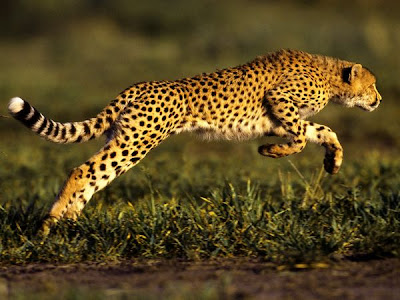THE INDIAN CHEETAH
(Acionyx jubatus venaticus)
This article of mine deals with one of the currently extinct subspecies of the world's fastest land animal - The Indian Cheetah. Sprinting at an incredible speed of almost 115 km/hr, the cheetah easily outruns any other living creature, thus dominating the list of fast runners. A light frame, flexible spine, narrow chest, deep waist and broad nostrils combined with a long tail and non-retractable claws make the cheetah a live running machine.
The size of adult cheetahs ranges from 110 to 150 cm in body length with the tail adding another 80 cm (approx.). The weight range is from40 to 70 kg with the males being slightly larger than females. Dark strips called TEAR STRIPES in the side of its eyes keep sunlight out and aid the cheetah in hunting. Although the cheetah may be a speed machine, it can't keep up the pace after a particular time as its body heats up rapidly while running.
The African Cheetah gearing up for a chase.
The Indian Cheetah (Acionyx jubatus venaticus) is the type of asiatic cheetah found in India. This creature which once raced across the indian grasslands is now completely extinct. The Indian Cheetah fed mainly on indian antelopes like the chital, blackbuck, chinkara, and other small mammals. Lot of theories exist about how the Indian Cheetah became extinct but the prime reason is HUNTING. Indian monarchs and British rulers hunted cheetahs and other wild animals for pride and pleasure, thus greatly affecting their populations in the wild. This combined with the lack of conservative efforts landed a fatal blow to the indian cheetah. Today asiatic cheetahs are found only in Iran.
The last three Asiatic Cheetahs recorded from India were shot down by Maharajah Ramanuj Pratap Singh Deo in Surguja, Madhya Pradesh,Central India seen in this photo submitted by his private secretary to JBNHS.
The Indian Cheetah once roamed the entire country of India as one of its top carnivores but man's activities caused a massive downfall in cheetah population. Cheetahs are the only Big cat that can be tamed and trained to hunt gazelle. The Mughal Emperor of India, Akbar, was said to have had 1,000 cheetahs at one time, something depicted in many Persian and Indian miniature paintings. The numerous constraints regarding the Cheetah’s conservation contribute to its general susceptibility and its very complex conservation requirements, e.g., its low fertility rate, the high mortality rate of the cubs, and the fact that females are the ones who select mates, have been reasons why captive breeding has had such a poor record.
Currently, wildlife experts have shortlisted three regions which have the potential to support cheetah populations. The Nauradehi wildlife sanctuary and Kuno-palpur wildlife sanctuary in Madhya Pradesh and the Shagarh grassland in Jaisalmer, Rajasthan have been declared potentially suitable for the reintroduction of the cheetah. The Kuno-Palpur Wildlife Sanctuary in Madhya Pradesh has the potential to hold populations of all four of India's big cats the tiger, the leopard, the Asiatic lion as well as the cheetah, all four of which have coexisted in the same habitats historically before they were wiped out due to over hunting and habitat destruction. Since the Shahgarh Landscape is fenced along the Indo-Pak border region, the addition of more fencing will ensure adequate protection for the cheetah population. The Nauradehi Wildlife Sanctuary (1197km2) is part of a much larger forested landscape (5500km2 ) which can host the cheetah as well.
- Vignesh CV.


No comments:
Post a Comment